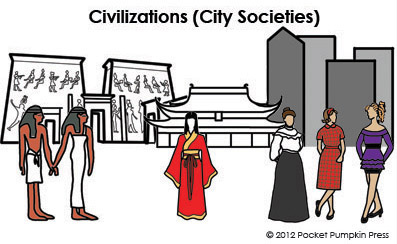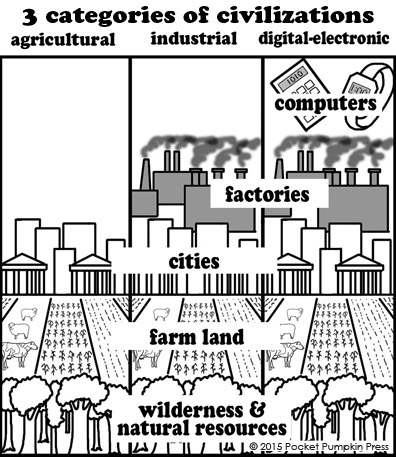Wilderness and Culture Class
Week 5 (15) - Week of April 11
Big History Unit 3:
Historic and Modern Civilizations,
History Timeline
Welcome to Big History Unit 3: the recent 6,000 years of Historic and Modern Civilizations. A “civilization” is a society that is large, has cities, imports many products and resources, and mostly eats farmed food. To the contrary, what we call a wilderness “tribe” (a. k a. hunter-gather society, indigenous society, primitive society) is a society that is small, lives in camps in the wilderness, has no cities, uses mostly local products and resources, and mostly eats wild food.
Vocab:
civilized and civilization – means a society with a city.
non-civilized and uncivilized – means a society without a city.
(In every type of society (tribal, agricultural, and civilized), there are many peaceful people. Being “civilized” means living a city-society’s culture, it does not mean peaceful. In the past, a few civilized people, who were prejudiced, assumed that uncivilized societies were violent and brutal. The truth is that many uncivilized people were and are very peaceful.)
People have been living in wilderness tribal societies for over 200,000 years. Only about 12,000 years ago, some people started farming. When a society begins to eat mostly farmed food, but does not yet have cities, the society becomes a “non-civilized agricultural” society. The amount of food grown each year is unreliable when farming. Some years, a surplus of food is grown. Other years, just enough food is grown. And some other years, too little food is grown, which is known as a famine. Sometimes, there are several decades favorable for farming, during which a society continually grows a surplus of food. Many consecutive years of a surplus of food results in population growth.
When an agricultural society grows such a surplus of food that its population significantly grows to form a city (such as over 1,000 settled people living in 1 square mile), that society becomes civilized.
In Mesopotamia, 4000 BCE (6,000 years ago), the agrarian society grew such as surplus of food that its population increased to formed into the first cities of Western Civilization. Also, tribal societies or agrarian societies, which assimilate into a city culture, become civilized. Each civilization has a city or cities, but not every person of a civilization lives in a city. For instance, many civilized people live and work on farms that supply food to a city or cities.


Civilization itself can be divided into 3 categories:
Agricultural Civilization (a. k. a. Pre-Industrial Civilization),
Industrial Civilization,
Digital-Electronic Civilization.
The 3 categories reflect merely an advancement of technology and a shift in professional jobs. Otherwise, all civilizations are fundamentally the same. All civilizations have large populations of people and cities that import many products and resources. They usually build big buildings. They all have farms and mostly eat farmed food. They all need nature and wilderness for natural resources.
● 6,000 years ago, the first civilizations were agricultural civilizations. Agricultural civilizations include: Ancient Greece, Ancient Rome, Ancient China, Ancient India, Ancient Egypt, Mayan Civilization, Aztec Civilization, Inca Empire, Mongol Empire, Mali Empire, Persian Empire, Muslim Empire, Medieval Feudal Catholic Europe, Colonial America, etc.
● Industrial civilization began in 1750 CE, upon England inventing the factory. During the age of industry, eventually, many people started using trains, cars, and analog electronics (telephones, electric lights, analog electric wall clocks, phonographs, etc.) and many people’s making-a-living shifted from family farms to factory jobs – meanwhile, the amount of farming actually increased. Big farming tractors and machinery can do a lot of farming while very few people do farm work. An industrial society cannot exist without farms and nature with its natural resources. Businesses bring natural resources into factories, at which they change natural resources into manmade products.
● Digital-Electronic Civilization began in 1950 CE, about when Alan Turing invented the first programmable digital electronic computer in 1945, in England. In 1957, the Russians launched the first satellite, Sputnik. In 1971, in the USA, the computer chip was invented and the first e-mail sent. The first ATM card was used in 1967, in England. In 1974, SWIFT, a group of 7 international banks set up a global network to have money wire transferred between different nations. Meanwhile, extreme globalization of products occurred. In the USA, many people buy food and clothes and toys made around the world at farms and factories of globalized corporations. Large globalized corporations continue to merge and monopolize on banking, insurance, fossil fuels, food, clothes, retail stores, media, technology, pharmaceuticals, etc. During the age of digital-electronics, eventually, many people started using digital technology (computers, digital wrist watches, digital televisions, digital telephones, and digital music files), and many people’s making-a-living shifted from manufacturing jobs (factory jobs) to service jobs – meanwhile, the number of factories and the amount of farmland actually increased. Today, in the Digital-Electronic Age, there are more factories in the USA, than ever before. Also, in the Digital-Electronic Age, in the USA, people are still eating farmed-food, which comes from farms in the USA and around the world. A digital-electronic society cannot exist without factories, cities, farms, and nature with its natural resources.
Anyway, in all civilizations, there are cities, huge people populations, many imported products and resources, farming, and nature, which is made into manmade products.
Highlights from a Timeline Segment from Big History:
6,000 years of Civilizations, Past to Present
4000 BCE (6,000 years ago) - Civilizations Begin, such as Sumer in the Middle East (Mesopotamia, Fertile Crescent) Ancient Civilizations include: Mesopotamia (Sumer, Akkadian, Babylon, Assyria, Babylon, Persia), Phoenicia, Egypt, Indus Valley, China. Early civilizations were ruled by kings or emperors.
500 BCE to 500 CE- Ancient European Western Civilizations: Greece and Rome. Greece set up many schools. Sparta had a national school system of standardized structured learning. Athens had small independent schools of free-thinking. Rome was a Republic and then an Empire. During the Roman Empire, an emperor had power.
500 CE to 1500 CE- Medieval Feudal Catholic Europe, pope has power (kings & knights are pope’s military). Meanwhile, there were many non-western Civilizations: China, India, Sassanid, Byzantine, Muslim, Mayan, Mississippian, Anasazi, Japan, Spanish Moors, Norse (Vikings), Aztec, Inca, Republic of Venice, Mongols, Ottoman, Mughals. These civilizations were ruled by kings or emperors. (Yes, the Mongols and Vikings and the others mentioned were all civilized - they all had cities and imported products and resources. The Vikings plundered Europe to bring stuff back to their Viking cities. All civilizations import stuff, through trade and war.)
1500 to Present - Western Civilization globalizes the world
Western Civilization Vastly Spreads
Businesses go Global (Dutch East India Co., etc.)
1500s – Renaissance Art, Spain & Portugal conquer Americas,
power shifts from pope to king (absolute monarch)
1600s – High-Tech Science Begins, Baroque Art
Dutch Republic & France conquer land,
England establishes 13 colonies
1700s – Age of Progress: Manifest Destiny: progress of high-technology, progress of clearing and cultivating global wildernesses into farmland, progress of assimilating many societies into Western Civilization’s economy, shopping, farming, technology, and Christianity.
Rococo & Neoclassical Art
France & England conquer lands
Height of English Enclosure Acts (common pasture land becomes privatized)
1750 CE – Industrial Civilization Begins, England invents the factory and industry; making-a-living shifts from family farms to manufacturing jobs.
1800s – Nationalism: power shifts from kings to nations
Art: Romantic, Realism, Impressionism
Age of Trains
Extreme Deforestation of USA
1850 CE- Prussia has best military and best industry and best national school system
Prussia copied ancient Sparta’s national school system, but industrialized it
USA and western European countries copy Prussia’s school system
1900s – Age of Speed, Cars, Telephones, Electric Lights, Urbanization.
Extreme Globalization: power shifts from nations to globalized banks & corporations
1900s Art: modern, cubism, fauvism, surrealism, abstract, expressionism, minimal, pop art, etc.
1900s high-tech science & inventions: e=mc2, DNA, computers, tv, airplane, space shuttle, satellites, atomic bombs
1939-40 World Expo in NYC - promotes that high-technology can improve society (end poverty, boost health, etc.)
1950 to Present – Digital-Electronic Civilization
Digital-Electronic Civilization
Extremely Globalized Economy
Extreme Global Deforestation
Global Electronic Banking
Age of Plastic, TV, Nuclear Energy, Nuclear Weapons
Global Electronic Internet Communications
Satellites, Space Exploration, etc.
making-a-living shifts from manufacturing to service jobs
1960s, 1970s – 3 billion people on earth, lots of poverty and pollution. Industrial Agriculture produces more food - claims to try to end poverty. Rise in environmentalism, Back to Land Movement, but, banks & corporations push high-technology & industry, super increase of high-technology, industry, and shopping.
2011 – 7 billion people, poverty & pollution increases: globalization, high-technology, & industrial agriculture were not helpful.
Today – people still aiming to help nature, society, health, joy, economy, freedom, peace, education, science, art, morals, etc.
Quiz Five (quiz 15)
1. A civilization is usually a …
a. large society, mostly eats farmed food, has cities, imports many resources, uses metal tools
b. medium to small society, mostly eats farmed food, no cities, uses stone or metal tools
c. small society, mostly eats wild food, no cities, mostly uses local resources, uses stone tools
2. In ancient Middle East (Mesopotamia / Fertile Crescent), roughly how long ago did
Western Civilization’s first civilization (Sumer Civilization) begin?
a. 1,000,000 years ago
b. 100,000 years ago
c. 10,000 years ago (8,000 BCE)
d. 6,000 years ago (4,000 BCE)
e. 2,000 years ago (1 CE)
3. What are the 3 categories of civilization?
a. primitive, agricultural, industrial
b. violent, semi-peaceful, peaceful
c. agricultural, industrial, digital-electronic
d. ancient, modern, post-modern
e. eastern, western, northern
4. In England, roughly how long ago did the Industrial Civilization begin?
a. 2,000 years ago (1 CE)
b. 1,000 years ago (1000 CE)
c. 500 years ago (1500 CE)
d. 250 years ago (1750 CE)
e. 100 years ago (1900 CE)
5. History of Education. Since 1850, the USA and several European nations have copied Prussia’s school system. What school system style did Prussia copy?
a. ancient Sparta, Greece, large national school system of mass forced learning
b. ancient Athens, Greece, small independent schools of free-thinking
c. medieval catholic church private schools using the quadrivium and trivium
d. none of the above
6. Since 1900, in the USA and around the globe, economic and cultural power has shifted from …
a. people to king
b. king to emperor or pope
c. emperor or pope to king
d. king to nation
e. nation to globalized banks and corporations
|


